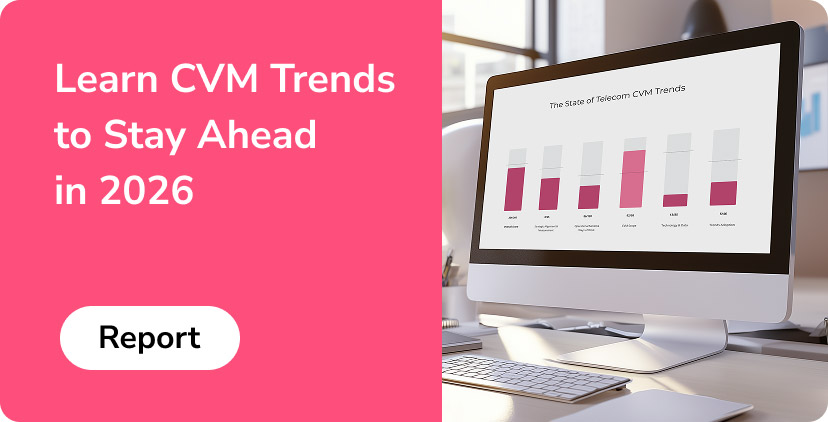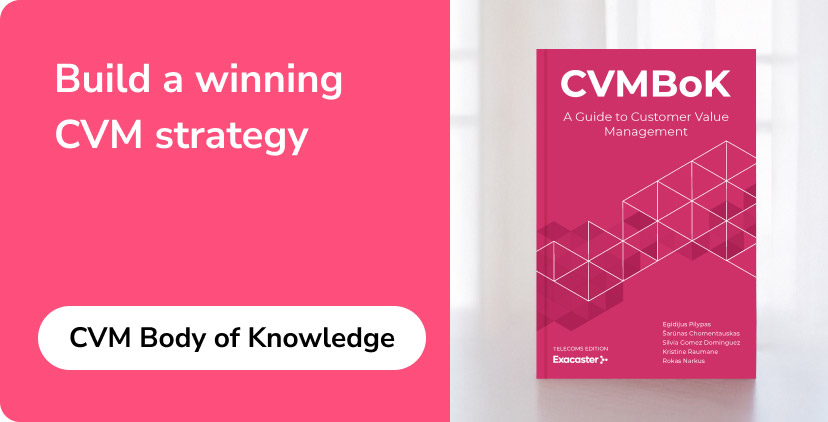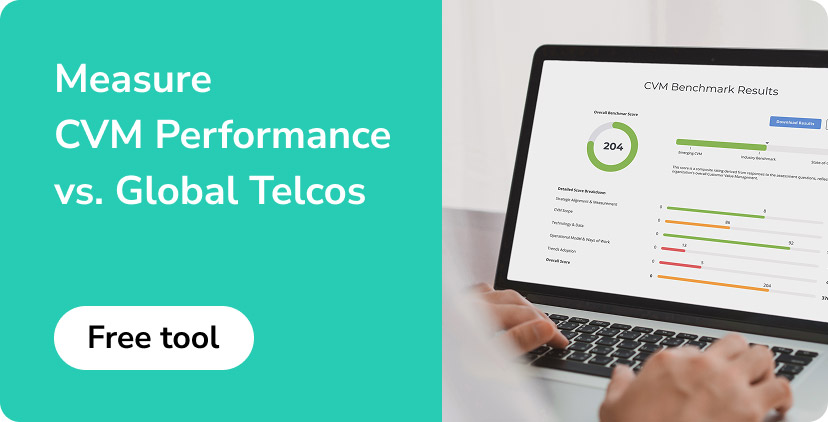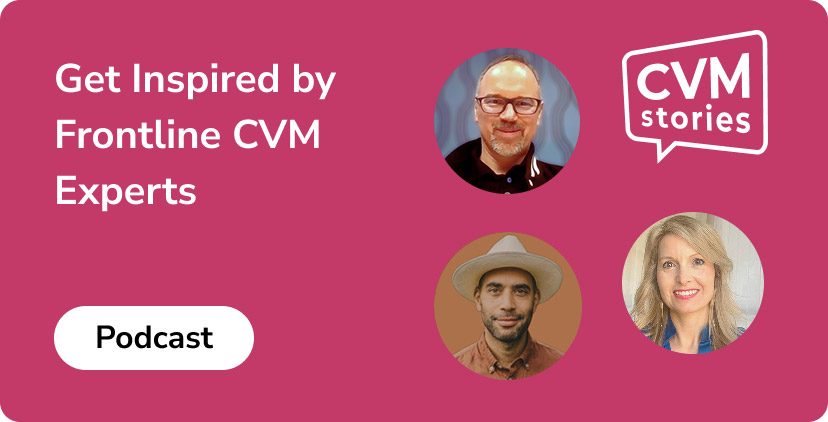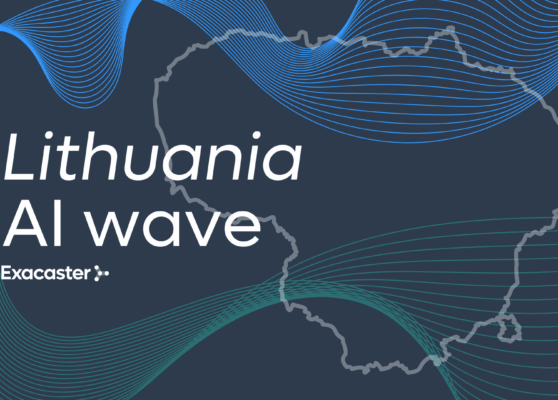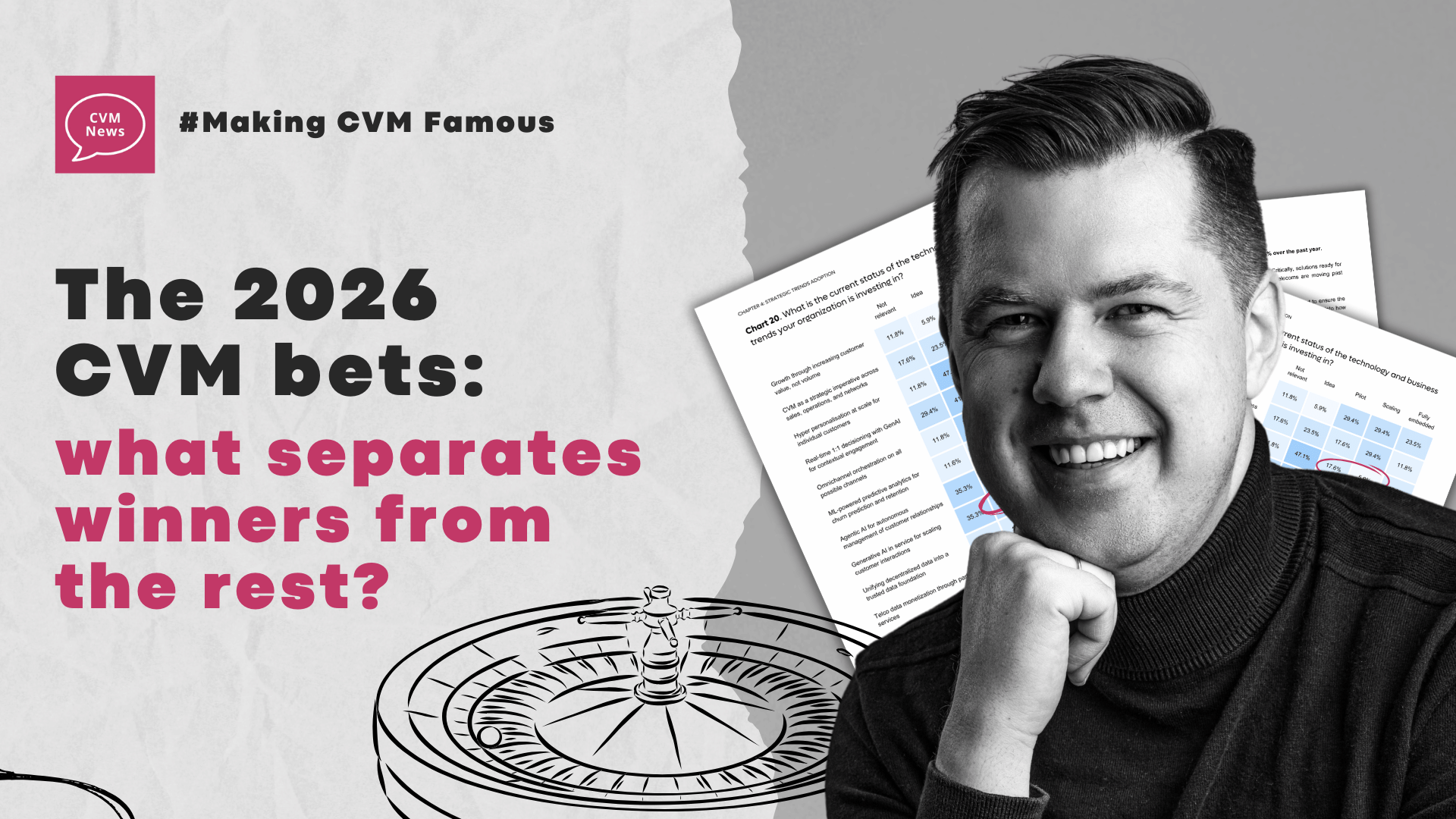Why Listen
In our new CVM Stories episode, you’ll meet Mohamed Mejri from Tunisie Télécom who navigates some of the strictest government regulations for a telecom in the world.
Tune in to hear how Mohamed together with the CVM team turn rules on pricing, targeting, and messaging into real ARPU growth.
5 Government Rules That Secretly Grow ARPU in CVM
Imagine you are in a regulated telco market: price, campaign timing, offer frequency are set by the regulator. So, what’s the smart CVM move?
- Escape the Price War
Rule: you can’t compete on price because all operator rates are fixed by law. CVM’s move: focus on knowing your customers so well that you can deliver the specific value they truly want.
- Prove Your Predictions
Rule: you must forecast every campaign’s results and then prove to a regulator that you were right. CVM’s move: turn this forecasting into an opportunity to improve predictive models and guide campaigns.
- Sell Nothing, Gain Everything
Rule: you are forbidden from selling anything to new customers for the first 30 days. CVM’s move: reframe this “no-sell” period as your golden opportunity to build trust and gather data for personalization.
- Make Every Message Count
Rule: you are limited to only 3 marketing messages per customer – with no exceptions. CVM’s move: make every campaign deliver so much value that customers look forward to your messages and think “Finally!” instead of “Again?”
- Target the Vital Few
Rule: your weekly campaign targets are capped – meaning you cannot reach everyone. CVM’s move: forget mass offers. Segment to find those most likely to convert based on signals or use the Next-Best-Action.
Episode Highlights
- A hyper-saturated market – 15 million users for 12 million people.
- Regulator pre-approves all campaign targets and forecasts.
- Post-campaign performance reporting is mandatory.
- Prices are fixed across all telecom operators.
- The first 30 days are for guidance only – no offers allowed.
- Campaigns are capped at 200k users weekly.
- Adapting CVM to cultural events like Ramadan is crucial.
- Deep segmentation is a requirement, not a choice.
- “Booster” campaigns targeting stable customers are most effective.
- CVM often acts as the company’s “emergency department.”
You must be someone who embraces failure, because here at CVM, ‘test and learn’ is the only way. – Mohamed Mejri, Tunisie Télécom
Recommendations for Growth as a Professional
To succeed in a challenging CVM environment, Mohamed suggests you must have a passion for numbers and data. Be prepared to think creatively to work within constraints – and, most importantly, accept failure. The “test and learn” approach means not every campaign will win, but every test provides a valuable lesson.
TRANSCRIPT
[00:00:00:08] Mohamed: If the customer has the three sims of 43 telecom operators. So [00:00:05:00] you must be the best to take the market share. Everything [00:00:10:00] is priced by and all the prices are made by the regulator. So [00:00:15:00] if you take the money, there is about 100 unique campaigns.
[00:00:19:09] Exacaster: Welcome to CVM [00:00:20:00] Stories, the podcast on customer value management. Together, we explore how companies [00:00:25:00] can be more successful and the customers happier through the use of latest customer value management techniques. [00:00:30:00] Learn key commercial and analytical insights from telecoms, retail, finance [00:00:35:00] and other industries that drive CVM forward.
[00:00:37:21] Egidijus: Hi, I’m your host, Egidijus. Today [00:00:40:00] our guest is Mohamed Mejri, commercial and marketing [00:00:45:00] analyst from Tunisie Telecom. Mohamed does magic with CVM [00:00:50:00] in an extremely regulated market. Growing ARPU under [00:00:55:00] super strict rules is a challenge. Yet he runs over [00:01:00:00] 100 campaigns every single month and the results are real. [00:01:05:00] So let’s learn how he does it. Hi, Mohamed, uh, [00:01:10:00] thank you for joining our CVM Stories podcast today. And [00:01:15:00] today we we will talk about how do you run a customer value [00:01:20:00] management, uh, in Tunisia? Uh, it’s a very exotic country for us. [00:01:25:00] Uh, but we are super interested to learn [00:01:30:00] something from you. From you. So, Mohamed, uh, [00:01:35:00] first super tough question for you is, uh, for, uh, [00:01:40:00] for those who are listening, can you explain us, uh, what [00:01:45:00] would you think that would surprise customer value manager [00:01:50:00] if they would need to start working, uh, in your country? [00:01:55:00]
[00:01:55:07] Mohamed: So first, uh, first, I want to thank you for this podcast. [00:02:00:00] I’m honored to be here with you. So as you said, I’m working at Tunisia [00:02:05:00] Telecom. Uh, one of three, uh, telecom operators here [00:02:10:00] in Tunisia. And we are based in Tunisia. Uh, for for the question. [00:02:15:00] The first thing that, uh, you will notice is the, [00:02:20:00] uh, the population here. We are almost [00:02:25:00] 12 million people here in Tunisia, but, uh, the, [00:02:30:00] uh, mobile users are about 15 million users. So [00:02:35:00] the market is very saturated and the, uh, the competitors [00:02:40:00] are doing everything to succeed in this TVM, uh, departments. [00:02:45:00] So that’s the first thing that you will notice.
[00:02:49:22] Egidijus: So, [00:02:50:00] uh, uh, acquisition you will not win the market with acquisition now because [00:02:55:00] all customers are acquired twice.
[00:03:00:06] Mohamed: Every [00:03:00:00] customer has the three themes of 43 Telecom. So [00:03:05:00] you must be the best to take the market share.
[00:03:10:02] Egidijus: Could [00:03:10:00] you tell us a little bit more about the usage [00:03:15:00] patterns? So is it data dominant. Is it voice dominant. What are basically kind [00:03:20:00] of the key services here?
[00:03:22:23] Mohamed: Uh, the market changed a lot since, [00:03:25:00] uh, ten, ten years with the launch of the 4G technology. Uh, [00:03:30:00] basically we were, uh, we were, uh, selling only, uh, fixed, uh, [00:03:35:00] fixed contracts, fixed services. But everything changed with [00:03:40:00] 4G and 3G technologies. So right now the [00:03:45:00] penetration is about 150% of the population. And, [00:03:50:00] uh, basically the market is turning around the, uh, Voice [00:03:55:00] usage. There is not really good data usage [00:04:00:00] and penetration. It’s about 30% of the population using 4G [00:04:05:00] services, 5G nowadays 5G services. But [00:04:10:00] uh, the market share is turning around the voice [00:04:15:00] services and uh, internet services. I’m [00:04:20:00] talking about VDSL and VDSL services [00:04:25:00] and fiber.
[00:04:27:10] Egidijus: When we talk about, uh, Tunisia. [00:04:30:00] Yeah. Um, I heard that, uh, you have, uh, kind of [00:04:35:00] your market is special not only from the, uh, high saturation of the services, [00:04:40:00] but also from the strong regulatory environment. Yes. [00:04:45:00] Uh, it’s like, uh, could you, uh, tell [00:04:50:00] us a little bit, uh, let’s say, uh, what are the regulation perspectives [00:04:55:00] that limit your as customer value manager scope?
[00:04:59:00] Mohamed: There are many there are many [00:05:00:00] limitations and many constraints. Uh, that regulator is [00:05:05:00] uh, uh, making us uh, uh, doing [00:05:10:00] to succeed. But for example, uh, start talking about our [00:05:15:00] CVM journey. So to launch CVM, CVM, or VTL [00:05:20:00] campaign, you should tell the regulator about the campaign, uh, the population [00:05:25:00] you will target, uh, the you will, you will gain, uh, [00:05:30:00] the, the, uh, conversation rate, everything you have to estimate before [00:05:35:00] you, you, uh, send the, uh, proposition for the regulator [00:05:40:00] and have the okay to go and launch the campaign. After launching the campaign [00:05:45:00] one month later, you have, uh, do the same thing and, uh, making [00:05:50:00] the follow up and sending the dashboard for the regulator, and you have [00:05:55:00] to prove that your estimation was good and your estimation, the [00:06:00:00] numbers you estimated are right. And, uh, and under the, uh, [00:06:05:00] the numbers that the regulator impose. So [00:06:10:00] everything you will do.
[00:06:13:20] Egidijus: Oh.
[00:06:14:12] Mohamed: Yeah, everything [00:06:15:00] you do is, uh, should be, uh, uh, very verified. [00:06:20:00] And you should have the okay of the regulator. Uh, that’s really [00:06:25:00] challenging. And that’s really making many constraints to succeed at [00:06:30:00] this business.
[00:06:31:10] Egidijus: So. Okay, tell me more, uh, about this. So, [00:06:35:00] uh, do I understand correctly that you, uh, for every campaign [00:06:40:00] you need to say, okay, for this amount of customers, we will send this [00:06:45:00] offer, and we expect this conversion. And this [00:06:50:00] is their revenue change basically. And then you need to follow them up with [00:06:55:00] that.
[00:06:55:05] Mohamed: Right.
[00:06:55:21] Egidijus: Right. So and do you need to do the same for recurring [00:07:00:00] campaigns like the ones that you would be running on a monthly basis. Uh, [00:07:05:00] or is it like do you do it once or how does it work?
[00:07:09:20] Mohamed: Uh, [00:07:10:00] you should you should, uh, uh, estimate everything before you, [00:07:15:00] uh, run it. And when you run it, you should be [00:07:20:00] in the in the estimation, for example, uh, and you should respect [00:07:25:00] the constraints that, uh, regulator tell us, for example, we [00:07:30:00] can’t launch campaigns or we cannot target, uh, population, [00:07:35:00] uh, up of 200 people per [00:07:40:00] week. And it’s very, very hard to do CVM, uh, business [00:07:45:00] with this, uh, this Limitations. Uh. For [00:07:50:00] example, we have 4 million, uh, B2B, B2C customers for 4 [00:07:55:00] million, uh, people using, uh, mobile phones. And, uh, [00:08:00:00] we should launch campaigns and target every one of them. So how we can [00:08:05:00] do to, uh, to launch only 200 K. [00:08:10:00] So sometimes we are, uh, making some fif and exceeding and [00:08:15:00] exceeding this 200, uh, level and going, uh, going [00:08:20:00] up. It’s, uh, we are obliged to make it.
[00:08:23:17] Egidijus: Yeah. Okay. So [00:08:25:00] it’s like, it’s a really interesting environment. It’s like it’s a challenging environment, but interesting. [00:08:30:00] It’s challenging at the same time. Yeah, [00:08:35:00] it is very challenging. Uh, but at the same time, I [00:08:40:00] cannot believe that you are. You must evaluate every CVM [00:08:45:00] campaign. Really? Really. Well. It’s like, uh, I haven’t [00:08:50:00] heard about the company that every campaign is kind of measured, reported [00:08:55:00] not only to the team, but it’s like to the other authorities. So your [00:09:00:00] reporting process should be like amazing.
[00:09:02:21] Mohamed: Very amazing. Well, once we had, [00:09:05:00] uh, a cooperation with the team from sass for, uh, for [00:09:10:00] launching new CVM tool. So when we asked the to ask them [00:09:15:00] to help us, uh, to make the automation of the reports, when they say [00:09:20:00] the Excel report we are preparing, they were amazed with it. Uh, it’s [00:09:25:00] really insane. Uh, the, the time and the effort we, [00:09:30:00] we put into preparing this, uh, dashboards and these reports. It’s very, [00:09:35:00] very, very impressive.
[00:09:37:00] Egidijus: Okay. Uh, so this sounds very, very [00:09:40:00] interesting. And, uh, uh, what are other, uh, kind of, uh, things [00:09:45:00] that you need to comply to when you do, uh, your campaigns. [00:09:50:00]
[00:09:50:19] Mohamed: Uh, it’s the changing and, uh, it’s very changing [00:09:55:00] behavior. Uh, uh, of the customers, uh, from [00:10:00:00] month to month, the behavior changes. Also, there is one other thing, and, [00:10:05:00] uh, that it’s very interesting. It’s seasonality, the seasonality effect here in Tunisia, it’s [00:10:10:00] very big. There is many seasons like the summer, during the summer everything changes. Uh, [00:10:15:00] during the Ramadan month, everything changes also. So, uh, [00:10:20:00] also our work changes with the behavioral changes. [00:10:25:00] Uh, and when you see the insights and the data analysis, [00:10:30:00] uh, that, uh, we are looking at, uh, you can’t [00:10:35:00] you can’t say that it’s the same behavior of the same customer. [00:10:40:00] So you have, uh, you should be flexible on the dynamic to challenge [00:10:45:00] these changes.
[00:10:47:06] Egidijus: Okay. This sounds again [00:10:50:00] very, very interesting. So for example, during Ramadan all the usage probably [00:10:55:00] moves towards the night time.
[00:10:56:23] Mohamed: Yes. Right.
[00:10:57:23] Egidijus: What are the patterns for us to [00:11:00:00] understand better?
[00:11:01:06] Mohamed: Uh, for example. Well everything [00:11:05:00] moves from the day to the, the afternoon and the night, uh, [00:11:10:00] the day, uh, every single person here, uh, starts [00:11:15:00] his day with at work with no food, with no beverages. So, uh, [00:11:20:00] full focus at work. Uh, after a small [00:11:25:00] rest at home, his [00:11:30:00] day, his day begins again. Begins with, uh uh, with [00:11:35:00] communication, with the seeing friends, with the going out of home. So you should, [00:11:40:00] uh, change your your behavior to and to change [00:11:45:00] your your daily work to adapt to the [00:11:50:00] changes seen at the customer behavior. For [00:11:55:00] example, campaigns become the campaigns become launched at the [00:12:00:00] afternoon. At the night, uh, we, the regulators give us the opportunity to [00:12:05:00] launch, uh, messages after 8:00 pm. Uh, something we can do [00:12:10:00] out of Ramadan, for example. Uh, some things like this.
[00:12:15:05] Egidijus: Wow. [00:12:15:00] This is so cool. But this [00:12:20:00] is, like, really like, uh, serving the customer with all [00:12:25:00] these changes and adoption. That’s really, really, uh, interesting [00:12:30:00] part. So, Mohamed, I see that your work is, uh, [00:12:35:00] uh, super, super challenging. Uh, so [00:12:40:00] how did you decide to become a customer manager? What was your story behind it?
[00:12:46:06] Mohamed: Not [00:12:45:00] a big story, but I was always impressed by working at [00:12:50:00] telecom operators. My first experience after studies was with orange, [00:12:55:00] our competitor right now. So when I got had the opportunity [00:13:00:00] to join Tunisie Telecom, I went into it. I was surprised because I [00:13:05:00] was not expecting that, uh, really, the work would be like this. Using data, [00:13:10:00] um, making queries, running, uh, campaigns. Uh, it [00:13:15:00] was, but it’s impressive. With time, I gained passion and [00:13:20:00] I had passion for this work. So the journey is going better to better. And [00:13:25:00] being very, uh, challenging with the, the the [00:13:30:00] changes, the market changes and the market trends. So it’s that [00:13:35:00] side of the work. It’s that’s what, uh, makes me challenging myself [00:13:40:00] every day to to bring new things, to adapt myself to the [00:13:45:00] trends and the changes.
[00:13:47:17] Egidijus: So you basically kind of had [00:13:50:00] a natural, uh, love for the telecom industry. [00:13:55:00]
[00:13:55:13] Mohamed: Yes.
[00:13:56:01] Egidijus: And uh, from, uh, like from becoming [00:14:00:00] a customer value manager. What what, uh, would you say are the key [00:14:05:00] aspects necessary for the professional to become a good [00:14:10:00] customer value manager?
[00:14:11:16] Mohamed: Uh, in my case, uh, my studies were I have [00:14:15:00] a diploma in customer relationship management. Also, I had, uh, another [00:14:20:00] diploma in, in maths, uh, campaigns, the both, uh, customer [00:14:25:00] relationship management with using data data sets and uh, uh, [00:14:30:00] using uh, data analysis. So, uh, that’s [00:14:35:00] the challenging side of the CVM to become a manager. You should you [00:14:40:00] not should you you you must have passion for [00:14:45:00] maths, for numbers, uh, for uh, you have, uh, think out of the box, [00:14:50:00] let’s say think of the records because you will be changing many trends, many changes. [00:14:55:00] You have to create new campaigns. Uh, you must be [00:15:00:00] someone who accept failure, who accept to fail because, [00:15:05:00] uh, here at CVM, we say we test and learn. When you test, [00:15:10:00] there may be you win, maybe you lose. So you have to accept [00:15:15:00] your lose. And, uh, come again with another idea. [00:15:20:00] Uh, come again with good insights. Uh, come again with other ideas [00:15:25:00] to launch another thing and, uh, try to make [00:15:30:00] your business go level up.
[00:15:33:11] Egidijus: It’s super dynamic environment. [00:15:35:00] Uh.
[00:15:36:00] Mohamed: Yeah.
[00:15:36:21] Egidijus: Definitely. So over those years, [00:15:40:00] when you are a customer value manager, I think you learned a lot. Um, and [00:15:45:00] I would like to go a little bit deeper into how [00:15:50:00] do you manage your customer lifecycle. So when do you start, uh, to [00:15:55:00] manage customer from the CVM perspective. And what programs do [00:16:00:00] you have.
[00:16:00:23] Mohamed: The journey of, uh, using, uh, data [00:16:05:00] and database and data analysis, uh, took us to use new [00:16:10:00] tools and using new tools. Let us ask the regulator for, uh, [00:16:15:00] when, when we can launch campaigns and [00:16:20:00] how we can, uh, manage our the lifecycle of our customer. So [00:16:25:00] we we start with the customer one month after, uh, the [00:16:30:00] acquisition, we, uh, we designed the many campaigns, acquisition campaigns [00:16:35:00] to guide them, to know how he can use, uh, his, uh, [00:16:40:00] his mobile, uh, who’s mobile services, which are his services? [00:16:45:00] Uh, this this kind of campaigns, uh, make us [00:16:50:00] know what kind of customer is he?
[00:16:53:01] Egidijus: I have a I have a question [00:16:55:00] for you about this, uh, uh, onboarding piece. So [00:17:00:00] why why do you start only one month after the acquisition? Uh, what [00:17:05:00] do you do before? Uh.
[00:17:08:21] Mohamed: We can only launch, [00:17:10:00] uh, informative messages, and, uh, all the informative messages are only automatic. [00:17:15:00] We can launch any anything from the CVM. So, uh, for [00:17:20:00] example, we launch an SMS. You can use this USSD code for, [00:17:25:00] uh, to obtain data bundles. For example, you can use this USD [00:17:30:00] for, uh, voice offers. This [00:17:35:00] kind of messages. You can, uh, check your, uh, your, uh, account. [00:17:40:00] By using this USSD code, you can use our, uh, self-care [00:17:45:00] application. All this during the first month, but [00:17:50:00] after one month, we can start making, uh, CVM and VTL, uh, [00:17:55:00] uh, campaigns.
[00:17:57:22] Egidijus: But is it your, uh, company’s, [00:18:00:00] uh, regulation, or is it also somehow, uh, related [00:18:05:00] to the regulation?
[00:18:06:14] Mohamed: It’s related to the regulation. It’s, uh, the regulator said, [00:18:10:00] uh, one month after, uh, the acquisition of the customer, you can [00:18:15:00] start, uh, making campaigns and trying to level up the revenue. [00:18:20:00]
[00:18:21:10] Egidijus: Okay. This is very interesting as well. I [00:18:25:00] haven’t heard such type of irregularity. This is so cool. You [00:18:30:00] know, so Your regulator actually kind of pushes you to do the, [00:18:35:00] the, the service really well. Like, uh, first [00:18:40:00] month only kind of onboarding and training. Customer. No. Offers nothing. [00:18:45:00]
[00:18:45:16] Mohamed: Only. Only guidance and training. Enough.
[00:18:48:22] Egidijus: Wow. This is very interesting. [00:18:50:00] I haven’t heard about this sort of regulation before. Okay. [00:18:55:00] So so after that one month you do some segmentation. Yes. So you try to identify [00:19:00:00] what type of users are your customers.
[00:19:04:11] Mohamed: Yes, yes. [00:19:05:00]
[00:19:05:21] Egidijus: What segments do you basically have or what key aspects you [00:19:10:00] try to identify?
[00:19:11:18] Mohamed: Uh, basically the first, uh, we wanted to [00:19:15:00] see if is a voice consumer, a data consumer, if he is [00:19:20:00] interested into data, interested into, uh, voice service, interested in both, uh, [00:19:25:00] what kind of bundles he is activating right now? Uh, what, uh, level [00:19:30:00] of, uh, usage. Is he, uh, going for so, uh, [00:19:35:00] during three months or less, maybe for between 40 days and [00:19:40:00] three months, we start launching the acquisition campaigns. Uh, acquisition campaigns [00:19:45:00] mostly are a failure, because during this, uh, this [00:19:50:00] time, you will, uh, see if your. What kind of segment is he, uh, [00:19:55:00] into. So after that, we can, uh, go [00:20:00:00] for the next step and try to make the, uh, [00:20:05:00] the right life cycle for the customer. For example, if he is a data adapter, [00:20:10:00] if he is. So we can adapt our work and our, uh, uh, [00:20:15:00] segmentation based on this three months after [00:20:20:00] the acquisition.
[00:20:22:03] Egidijus: So basically, uh, depending on where the [00:20:25:00] customer is using data or not using data, you can say, okay, kind of if [00:20:30:00] customer is not using data, most likely it will be super hard to convert them to data users [00:20:35:00] because they already would have done it over the first few months. Yeah. [00:20:40:00]
[00:20:40:03] Mohamed: Yes, yes, we are always trying to to bring them into [00:20:45:00] using data, even if they are not use it because, uh, the [00:20:50:00] data is the main challenge for the uh, management at Telecom. So, uh, we [00:20:55:00] should and we are always launching campaigns for, especially for data to, uh, [00:21:00:00] train, train the customer to use the data of telecom. [00:21:05:00] We are better. We are the best. Uh, messages like this.
[00:21:09:14] Egidijus: Uh, what [00:21:10:00] prevents basically the the bigger population from using data? [00:21:15:00] Uh, uh, is it kind of. Well, uh, what [00:21:20:00] are the challenges here?
[00:21:21:17] Mohamed: Uh, the challenges are, uh, uh, [00:21:25:00] coming with the, uh, the network itself with the [00:21:30:00] changes into 5G since, uh, since February, we are facing some problems [00:21:35:00] like this. Uh, customers are now, uh, uh, [00:21:40:00] looking for what is the best operator for 5G. So 5G [00:21:45:00] is a trend. So customers are going from, uh, testing one [00:21:50:00] one operator to another operator, uh, to check the [00:21:55:00] quality of the network so they can, uh, go with him, uh, for the [00:22:00:00] coming, uh, for the coming few years, uh, if we can say that, uh, so the [00:22:05:00] network quality, the saturation here in Tunisia is very saturated. There is [00:22:10:00] places where the network is always down. So, uh, these are the main challenges. [00:22:15:00] Uh, they are, uh, basically technique, technical challenge. So to, [00:22:20:00] uh, the solution for this is to be dynamic, [00:22:25:00] to be aggressive in the offers to go behind the usual offers [00:22:30:00] that we are given for the customers to make it. Because with this [00:22:35:00] situation, with the network quality, we are going right to the churn. [00:22:40:00] So we have to prevent the churn and make our customers keep [00:22:45:00] with us for the coming years.
[00:22:50:02] Exacaster: If [00:22:50:00] you are interested in customer value management, check out our Customer Value Management body [00:22:55:00] of knowledge. CVM blog is a comprehensive guide for CVM professionals offering tips, [00:23:00:00] tools and best practices to help you in your job. Visit cvmbok.com [00:23:05:00] for more.
[00:23:07:02] Egidijus: So I assume that you should have quite a lot of multi [00:23:10:00] simmers here, so people who would have like two sims in [00:23:15:00] one phone or would be swapping sims. Uh, do you do anything interesting [00:23:20:00] with these guys?
[00:23:22:11] Mohamed: Uh, basically it’s is difficult to change [00:23:25:00] the behavior. For this this kind of customized [00:23:30:00] because the Multisim is always using a SIM for data usage and [00:23:35:00] another SIM for voice, uh, voice usage. So the solution [00:23:40:00] is to try to bring him with us for the data. If he is not, uh, [00:23:45:00] he does not adapt our data usage. We will go to in the, [00:23:50:00] uh, target him into upsell campaigns in the voice usage [00:23:55:00] so we can take the revenue a level up with something [00:24:00:00] that he needs and something what he wants from Tunisie Telecom. Uh, we [00:24:05:00] can be stubborn with the people who can will never use [00:24:10:00] your, uh, your service. So, uh, try to understand him and [00:24:15:00] give him the right offer to get his, uh, loyalty and take [00:24:20:00] his, uh, The revenue goes up.
[00:24:24:03] Egidijus: And Mohamed, [00:24:25:00] have you seen any let’s say good ways to identify [00:24:30:00] those multi simmers? Because if you know that the customer is multisim and [00:24:35:00] that they use data with other operator, then [00:24:40:00] it’s easier to give some offers etc.. Uh [00:24:45:00] how how how can you identify those customers basically.
[00:24:48:21] Mohamed: Uh, basically it’s [00:24:50:00] a data mining, uh, data mining, uh, job. So we, [00:24:55:00] they make a look at his, uh, community, uh, the, [00:25:00:00] uh, with his, at his community, if [00:25:05:00] he is, uh, talking too much or, or talking too much other, uh, to [00:25:10:00] people from other operators, uh, seeing the [00:25:15:00] his data record, uh, someone with the handset 5G handset He [00:25:20:00] is not using your data. Uh, it must be, uh, [00:25:25:00] multicenter. There is no, uh, no other chance [00:25:30:00] to that he will. He is not using data. Uh, we have also, uh, [00:25:35:00] parameters that we can see if the nature of the sites that he is [00:25:40:00] going into. Uh, when someone is going into sites like, and using apps [00:25:45:00] like Facebook, uh, and other apps and don’t use your [00:25:50:00] data, uh, of course, is using the data of another operator. So it’s [00:25:55:00] qualified, like a multicenter and, uh, enters into the uh, campaigns [00:26:00:00] for launched for the multi.
[00:26:03:16] Egidijus: So you have made quite [00:26:05:00] a lot of, uh, deep analysis there. So, um, and [00:26:10:00] uh, kind of, um, how hard is [00:26:15:00] it to, uh, make someone switch?
[00:26:18:22] Mohamed: It’s very hard. It’s very [00:26:20:00] hard. Uh, as I said, we can’t be stubborn in trying to make him [00:26:25:00] switch. Uh, if he if he don’t switch into 2 or 3 times, uh, [00:26:30:00] it’s better to go and give him a better offer and to in [00:26:35:00] the service he is interested for, uh, if [00:26:40:00] someone is interested in into voice services and he [00:26:45:00] doesn’t switch his data usage into, uh, for telecom, uh, [00:26:50:00] it’s you can’t make effort for, uh, for, uh, for nothing. [00:26:55:00] So, uh, it’s for us to change our ideas and to [00:27:00:00] change our, uh, the way we we are, uh, we [00:27:05:00] are working at, uh, this kind of customers.
[00:27:08:19] Egidijus: But that smart is good [00:27:10:00] that you are not over communicating. You know, you’re not trying to, um, push [00:27:15:00] them too hard.
[00:27:16:15] Mohamed: Because it’s another constraint from the operator. We can’t launch more than [00:27:20:00] three SMS for each customer, [00:27:25:00] so.
[00:27:25:23] Egidijus: Three SMS per customer per which period of time.
[00:27:31:01] Mohamed: So [00:27:30:00] you have to make the option to call [00:27:35:00] the optimal the optimal choice.
[00:27:39:10] Egidijus: Okay. Uh, [00:27:40:00] so Mohamed, you have so many regulations. [00:27:45:00] So how many campaigns do you run per month, per, per week, per week?
[00:27:50:05] Mohamed: They [00:27:50:00] are they are the same. The same, uh, campaigns we are launching, uh, during, [00:27:55:00] uh, every week. So if you take the month, there is, uh, about 100 [00:28:00:00] unique campaigns.
[00:28:01:12] Egidijus: 100, 100.
[00:28:03:00] Mohamed: Campaigns, for example.
[00:28:04:17] Egidijus: And [00:28:05:00] each you have to specify, get approval from the regulator and provide [00:28:10:00] the data about the performance.
[00:28:13:00] Mohamed: We we got the approval, the approval from the regulator. [00:28:15:00] But, uh, it’s been some time that we are that we didn’t [00:28:20:00] change the campaign. So for now, we are not launching new [00:28:25:00] campaigns. We still testing the campaigns for a period of three of three months at least. [00:28:30:00] Uh, after three months we can change. If the campaigns are not good, we will change. [00:28:35:00] Uh, we should adapt ourselves for the regulations and [00:28:40:00] the regulatory constraints. Uh, so, uh, one [00:28:45:00] 100 unique campaigns. It gives us the opportunity to go into [00:28:50:00] very, very deep level of segmentation and targeting for our customers. Uh, and [00:28:55:00] good segmentation and good knowledge of the customer make better, [00:29:00:00] uh, conversation, uh, rates and better [00:29:05:00] revenue, uh, uh, up levels.
[00:29:09:13] Egidijus: But I [00:29:10:00] am super impressed, you know, with even with this such a regulation, you can run over [00:29:15:00] 100 campaigns. This is amazing. Um, so, [00:29:20:00] uh, I wanted also to ask you about a little bit about how deep is your segmentation? [00:29:25:00] Uh, then if you have 100 campaigns, how [00:29:30:00] many segments do you typically have? What is the size of your campaign?
[00:29:34:11] Mohamed: Uh, it [00:29:35:00] goes from some fountains of about 2000 for [00:29:40:00] 40,000, uh, maybe £50, uh, segment [00:29:45:00] divided into, uh, uh, upsell into retention and to [00:29:50:00] churn and to cross-sell, uh, campaigns. So [00:29:55:00] in the, in every type of campaign, uh, it’s divided into recharge [00:30:00:00] and to voice consumption and to data boost and to data consumption, uh, [00:30:05:00] and data bundles, activation campaigns. Uh, so we go deep into [00:30:10:00] the data because we are using some machine learning models. Uh, [00:30:15:00] and, uh, we are very going very deeply into the data consumption [00:30:20:00] and, uh, the data usage, uh, and we the we are now going [00:30:25:00] uh, the new challenge for telecom is going for, uh, uh, big data solution. [00:30:30:00] So with the big data solution, we will be going better [00:30:35:00] for our customers and we will know better the customer behavior. So [00:30:40:00] you can be better, uh, close and to to the customer.
[00:30:44:14] Egidijus: Mohamed, [00:30:45:00] you are doing so much. How big is your team?
[00:30:47:18] Mohamed: Uh.
[00:30:48:15] Egidijus: Sounds like. I don’t know, 50 [00:30:50:00] people, you know.
[00:30:51:20] Mohamed: 50 or 50. Uh, right now we are [00:30:55:00] at the team. We are 12 divided into three divisions. Yeah. Uh, three [00:31:00:00] for the campaigns and, uh, the CVM, uh, management [00:31:05:00] launching campaigns, making the reports, making the follow [00:31:10:00] up, uh, uh, dashboards. Uh, eight people in [00:31:15:00] the data mining team, and they are making a very huge amount [00:31:20:00] of work. Uh, and other the other three people in another [00:31:25:00] division we are using, uh, launching, uh, geo marketing campaigns. So we [00:31:30:00] need geo marketing, uh, experts.
[00:31:34:03] Egidijus: So you [00:31:35:00] even do the geo located, uh, targeting. Like if you enter a specific [00:31:40:00] location, you get, uh, some offers.
[00:31:43:21] Mohamed: Until now, we have only [00:31:45:00] the, the go to, uh, target people, uh, who are located [00:31:50:00] into the, um, uh, airports. So [00:31:55:00] we are launching a special campaigns for, uh, the, um, roaming [00:32:00:00] services for the people who are located into, in the airports. That’s, [00:32:05:00] uh. Okay. We have the [00:32:10:00] okay for only these, uh, the only the airports not [00:32:15:00] we are not eligible to target people or see the, uh, the real time [00:32:20:00] position of customer, uh, at every, uh, everywhere in the country, [00:32:25:00] but only in the airports. It’s another limitation.
[00:32:28:01] Egidijus: Also, I am super impressed. Impressed, [00:32:30:00] by the way, with your regulator. You know, they really, uh, [00:32:35:00] kind of push you to the absolute limits so that you would not, you [00:32:40:00] know, you will not send a single campaign to the whole base. You need to segment. [00:32:45:00] You need to be very precise. It’s like, wow.
[00:32:48:23] Mohamed: It’s a must. When [00:32:50:00] we are limited in the into 200 K, uh, [00:32:55:00] target, uh, every day, you should go [00:33:00:00] deeply into your data and, uh, try to, uh, target and [00:33:05:00] segment the customers into to two small segments so [00:33:10:00] you can take the best of your campaigns.
[00:33:14:05] Egidijus: Now, through [00:33:15:00] all those years when you are actually running the campaigns, which type of campaigns actually [00:33:20:00] give the biggest business impact? Uh, because kind of, [00:33:25:00] uh, in the very old days when I would start, uh, when I started the CPM [00:33:30:00] career, uh, the idea was, okay, we do a churn prediction, and [00:33:35:00] then we send the offer to customers who are most likely to churn, and we will get the best [00:33:40:00] outcome. But, uh, for many years, uh, I failed to [00:33:45:00] see that this is the the best performing campaigns. What, uh, what are [00:33:50:00] your best performing campaigns?
[00:33:52:03] Mohamed: Uh, the best performing campaigns are the booster [00:33:55:00] campaigns when we, uh, target customers [00:34:00:00] who are already stable and already generating some, uh, some good income. [00:34:05:00] So the idea is to take them to another level of consumption, even [00:34:10:00] if we, uh, suggest another another type of service, maybe data, [00:34:15:00] maybe, uh, value added service, uh, for for free. Uh, maybe, [00:34:20:00] uh, another, uh, some some minutes of free usage. [00:34:25:00] So uh, the, the campaigns who are targeting, uh, [00:34:30:00] already stable customers are the best ones who are generating a good income [00:34:35:00] for the, uh, anti campaigns. Uh, they are [00:34:40:00] not really generating, uh, good income, but they are animating the, [00:34:45:00] the base. Uh, when you animate the base, you will prevent, uh, [00:34:50:00] customers from churn. So, uh, it’s going in the positive way, [00:34:55:00] but not that really successful.
[00:34:58:09] Egidijus: It’s good to hear that your learnings [00:35:00:00] are also, uh, similar ones. Um, [00:35:05:00] so you have a lot of limitations with the campaigns, the way you can target, [00:35:10:00] uh, clients, etc.. Do you have any limitations with the product portfolio? [00:35:15:00] Like, can you, uh, can you have as many products as you want? How [00:35:20:00] is the pricing managed, etc.? Or are there also regulations [00:35:25:00] here?
[00:35:25:15] Mohamed: Of course. Uh, every everything is priced by and all [00:35:30:00] the prices are, uh, made by the regulator. So, uh, even the output is [00:35:35:00] made by the regulator, and you can’t exceed, uh. Some [00:35:40:00] amount of revenue. So, uh, but I [00:35:45:00] see this this, uh, limitations, uh, positively in some way, [00:35:50:00] uh, with this kind of limitation, we are going deeply with our data [00:35:55:00] usage, uh, our data consumption, the the, our, uh, the data of our customers. [00:36:00:00] We are going deeply with, with it to understand it and take a very [00:36:05:00] good insights. And we are using it back to to make [00:36:10:00] a difference and make good results. It’s not always bad [00:36:15:00] to have a very strong regulator like like the [00:36:20:00] ours.
[00:36:21:04] Egidijus: Yeah, I’m not saying that it’s bad. It’s just like it’s very, [00:36:25:00] um, interesting. It’s very strict, basically, uh, regulation. And [00:36:30:00] when we talk about the price plans. Yeah. So, so you are regulated [00:36:35:00] as a company, but are your competition your competition is also regulated [00:36:40:00] or not? Yes. And the price points of the products, are they the same or are. [00:36:45:00]
[00:36:45:16] Mohamed: They are they are the same for all the companies. For example, uh, one [00:36:50:00] gigabyte internet. It’s the price of one giga. It’s about €1.2 [00:36:55:00] here. So it’s €1.2 for telecom, [00:37:00:00] for orange and even for orange. So, the how [00:37:05:00] do you make a profit when the customer is using more and more?
[00:37:10:12] Egidijus: So [00:37:10:00] you basically need to need to provide a better service if you want to compete. You cannot [00:37:15:00] compete on price. You can only compete on better service. And uh.
[00:37:19:00] Mohamed: Right. Even if [00:37:20:00] you can’t change the the service technically or go into the [00:37:25:00] the field and try and make the things change there, you can, uh, [00:37:30:00] you can do your job with the CPM when you you can when [00:37:35:00] you understand the customer what he wants, uh, uh, really wants, you [00:37:40:00] will be successful and you will succeed. Your mission, uh, when you will succeed your mission, you will [00:37:45:00] take your the revenue you want and you will exceed the the [00:37:50:00] revenue goals.
[00:37:51:18] Egidijus: Yeah, definitely. That’s super interesting. Uh, so [00:37:55:00] you’re really interesting market. So it’s like [00:38:00:00] because you’re nailing the CVM.
[00:38:04:00] Mohamed: The market, the [00:38:05:00] market here is shared by three, uh, three companies. But, [00:38:10:00] uh, I think I think it’s only a market for two only companies. [00:38:15:00] Uh, three. It’s going, uh, behind the limits.
[00:38:23:01] Egidijus: Wow, [00:38:20:00] that sounds super [00:38:25:00] interesting. So. Okay. Um, Mohamed, I think it was super [00:38:30:00] interesting to hear, um, the aspects of [00:38:35:00] customer value management in Tunisia. Now, uh, [00:38:40:00] we will move to the stage, uh, where we ask our [00:38:45:00] CVM’s, uh, to share some personal stuff, uh, about, [00:38:50:00] uh, the career itself. Yeah. So, uh, first thing that [00:38:55:00] we are always asking is what what was your proudest [00:39:00:00] moment in your career that you could share with us?
[00:39:05:06] Mohamed: Uh, [00:39:05:00] seeing the new CVM tool that we made [00:39:10:00] a big effort. Me and my team, uh, running [00:39:15:00] and being successful and, uh, working without any problems. [00:39:20:00] Maybe this one is one of the most, uh, uh, one [00:39:25:00] of the most achievements that I am proud of. Uh, we took a lot of, [00:39:30:00] uh, a lot of time, uh, a lot of efforts, a lot [00:39:35:00] of, uh, thinking, brainstorming. And, uh, it costed a lot for the [00:39:40:00] company. So we I am proud to see it successful [00:39:45:00] and going very well.
[00:39:47:12] Egidijus: How much time did it take you [00:39:50:00] to. Deploy or set up [00:39:55:00] everything from the idea when you said that. Okay. We need a new tool. [00:40:00:00] Until all your processes were in this new tool. How much time did [00:40:05:00] it take? I have my bets, but I want to hear what you will say.
[00:40:09:15] Mohamed: Use [00:40:10:00] the idea from the idea to to decide who, what, what [00:40:15:00] tool. We will. We will be, uh. Uh. Buying it [00:40:20:00] took. It took years to to prepare the budget, to prepare [00:40:25:00] the requirements, to prepare the technical requirements, uh, the teams, [00:40:30:00] the human needs. Uh, but, uh, to [00:40:35:00] after we decided what solution we will be using, it took, uh, around [00:40:40:00] two years to, uh, install it technically to, make the [00:40:45:00] data ready [00:40:50:00] to be useful and to run the campaigns and [00:40:55:00] the reports it took almost two years.
[00:40:59:07] Egidijus: I thought [00:41:00:00] that it takes around two years to make a decision and then two [00:41:05:00] years to implement. So it’s four years.
[00:41:07:19] Mohamed: Maybe 4 or 5. That is close. [00:41:10:00]
[00:41:11:15] Egidijus: Yes. Yeah. It’s a [00:41:15:00] it’s a really big project actually. It’s like super.
[00:41:19:00] Mohamed: Big.
[00:41:19:06] Egidijus: Project to [00:41:20:00] change.
[00:41:20:17] Mohamed: The strategic projects for the for Tunisie Telecom, for the company. Uh, [00:41:25:00] and so that’s so, uh, we took a lot [00:41:30:00] of time.
[00:41:31:12] Egidijus: Yeah. But you can be proud that you made it also [00:41:35:00] with, uh, you know, with proud moments comes, uh, lessons, you know, [00:41:40:00] and some failures. Could you share a failure or two in your, uh, career? [00:41:45:00]
[00:41:46:04] Mohamed: Before using the new CVM Stories was using [00:41:50:00] some, uh, manual, uh, tools, uh, we extract the data [00:41:55:00] from the database, put it into a txt file, [00:42:00:00] and put the file into another tool to launch the SMS and [00:42:05:00] put the file the same file as another tool to launch the [00:42:10:00] bonus and make the campaign run. So once I launched the the [00:42:15:00] wrong message for the the wrong population and [00:42:20:00] the problem I the problem I coded was very, very, [00:42:25:00] very big. Uh, the uh contact center [00:42:30:00] were emerged by the number of uh, of, uh, uh, claims, [00:42:35:00] uh, for the bonus and for, uh, the, the amount that [00:42:40:00] the people paid. So it was very, very embarrassing [00:42:45:00] for me.
[00:42:47:20] Egidijus: Did you got fined by a regulator? [00:42:50:00] Uh.
[00:42:51:01] Mohamed: No. No, not for this one. But we got fine. [00:42:55:00] For another one when we [00:43:00:00] got one, because we launched the bonus. More than [00:43:05:00] that, we are allowed to to launch. So. And they [00:43:10:00] say the message and try it and try to get the bonus. And when [00:43:15:00] they say the result okay we should find them and we got find.
[00:43:20:17] Egidijus: Oh. [00:43:20:00] And uh, Mohamed, [00:43:25:00] uh, I don’t know that uh, I think that nobody [00:43:30:00] teaches you about customer value management, at least in universities. [00:43:35:00] Um, so how do you how do you learn, uh, about this? What [00:43:40:00] is your, uh, recommendation?
[00:43:43:12] Mohamed: Everything is based on the [00:43:45:00] data and how to use your data and your knowledge of the customer. Uh, [00:43:50:00] to be successful, you should know your customer deeply. You should go into [00:43:55:00] his historic usage and historic, uh. Uh, to see [00:44:00:00] his usage for your services. When you know what is, uh, interested [00:44:05:00] for interested in what he wants. Really, you will be succeed in your [00:44:10:00] journey with CBM. Uh, and you should be, uh, [00:44:15:00] a fair loser. What kind of a loser? You accept that? Uh, your, [00:44:20:00] uh, your campaign may be a failure. Maybe, uh, you should [00:44:25:00] test and learn from your test. Uh, you should learn from your [00:44:30:00] failure. So, like that, you can go step forward with your [00:44:35:00] CBM, uh, journey.
[00:44:38:00] Egidijus: I think these are very practical [00:44:40:00] words. Also, you need to be creative. Yeah. Yes.
[00:44:43:16] Mohamed: Yes, yes, you should [00:44:45:00] be creative. Especially with the regulation limits.
[00:44:49:08] Egidijus: Yes. And, [00:44:50:00] uh, I have a last question for you. I think [00:44:55:00] this is the toughest question is how do we make customer [00:45:00:00] value management management famous around the world?
[00:45:04:22] Mohamed: We [00:45:05:00] change the customer value management. Uh uh, sentence with [00:45:10:00] emergency. Yes. We [00:45:15:00] are doing very emergency. Very, very big amount of [00:45:20:00] emergency work. Uh, when there is a gap in something. Okay, [00:45:25:00] call CVM, they will find the solution. Okay. Launch a campaign to make this [00:45:30:00] go better. Uh, okay. Uh, send messages for this [00:45:35:00] target to tell them that something. So emergency is good for us.
[00:45:41:12] Egidijus: This [00:45:40:00] is a super cool analogy. Wow.
[00:45:44:20] Mohamed: The emergency [00:45:45:00] department.
[00:45:51:16] Egidijus: Sounds [00:45:50:00] very good. So thank you Mohamed for sharing [00:45:55:00] your insights and sharing your story today.
[00:45:57:23] Mohamed: Thank you. I’m honored [00:46:00:00] to be here with you. Uh, and I’m happy to have this conversation [00:46:05:00] with you. It was an interesting moment. Uh, a very good time with you. And, [00:46:10:00] uh, it’s it’s everything I said. It’s, uh, is coming from my passion [00:46:15:00] for the CVM. And, uh, it’s all everything coming [00:46:20:00] from my journey with this event. Thank you also, for the [00:46:25:00] last thing I will say is thank you for this. Your mission to make [00:46:30:00] CVM, uh, famous.
[00:46:32:23] Exacaster: CVM Stories is produced by Exacaster. [00:46:35:00] We help companies take their customer value management to the next level. To stay updated [00:46:40:00] on our latest episodes, subscribe to the podcast or sign up for an email newsletter at exacaster.com/cvmstories. [00:46:45:00]
